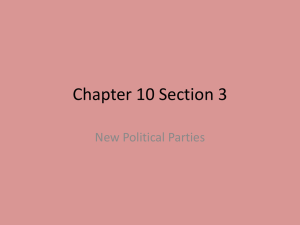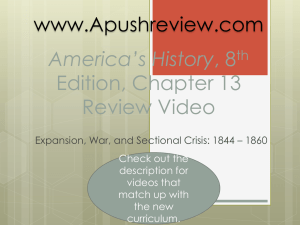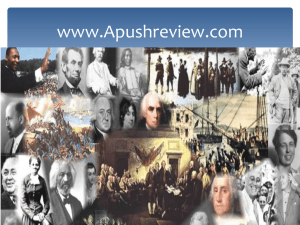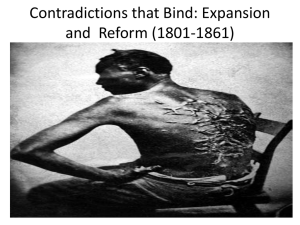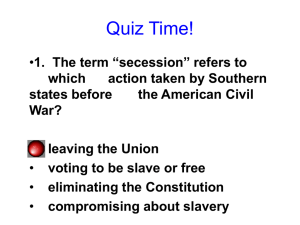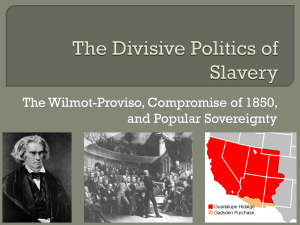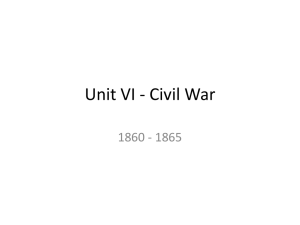21_1 Compromise of 1850
advertisement
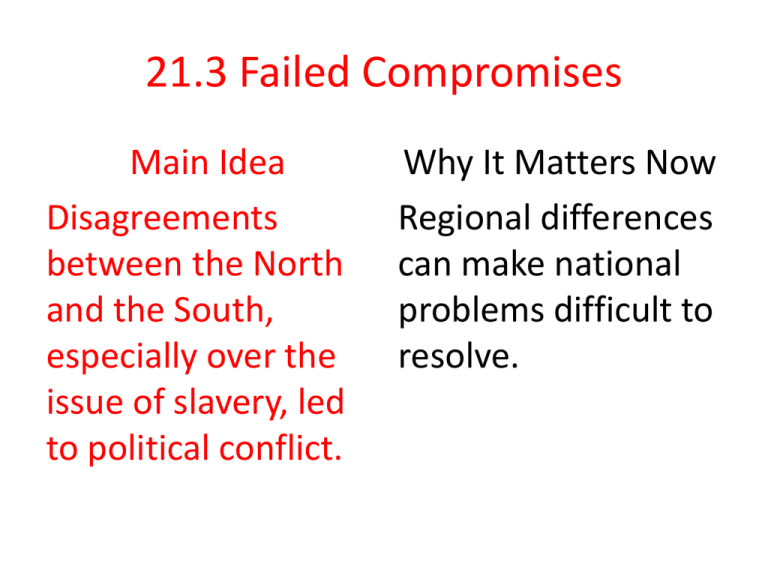
21.3 Failed Compromises Main Idea Disagreements between the North and the South, especially over the issue of slavery, led to political conflict. Why It Matters Now Regional differences can make national problems difficult to resolve. CA. Standards • 8.9.4 Discuss the importance of the slave issue as raised by the annexation of Texas and California’s admission to the union as a free state under the Compromise of 1850. • 8.9.5 Analyze the significance of the States’ Rights Doctrine, the Missouri Compromise (1820), the Wilmot Proviso (1846), the Compromise of 1850, Henry Clay’s role in the Missouri Compromise and the Compromise of 1850, the Kansas-Nebraska Act (1854), the Dred Scott v. Sandford decision (1857), and the Lincoln-Douglas debates. Daily Guided Questions 1. How did the admission of new states to the Union fuel the debate over slavery and states’ rights? 2. How did the nation try but failed to deal with growing sectionalism? 3. Why did Calhoun oppose California’s admission to the Union? 4. What was the Compromise of 1850, and why did it fail? Quick Write Wilmot Proviso • No slavery in territory gained from Mexico. • North -Wants to end the spread of slavery. -Slave terr. adds slave states. -No jobs for free workers. • South -Slaves are property protected by the Constitution. -Fears more free states. Free-Soil Party • Opposes spread of slavery into territories. -Not abolitionist. -Worried about white wage-based labor. • Made up of Democrats and Whigs. • Ex-president Martin Van Buren was their candidate for the 1848 election. • Lost election to Zachary Taylor. California Annexation • Backed by President Taylor. • Statehood would upset balance between free and slave votes in congress. -South threaten to secede. • Henry Clay of Kentucky proposes compromise to save Union. Henry’s Compromise • CA. Free State • Fugitive Slave Law • Popular Sovereignty- territory votes for slavery or not. • Government pays Texas $10 mil. for eastern New Mexico. • Slave trade banned in Washington D.C. -Allows slavery Debate over Compromise • North • Daniel Webster • Asked for compromise to preserve Union. • South • John C. Calhoun • Annexation of CA. would threaten Southern way of life. • Demanded constitutional amendment to protect states’ rights. • Or Secession. Webster Calhoun Compromise of 1850 • To please the North • Statehood of CA. • Banned slave trade in D.C. • Popular sovereignty • To please the South • Popular sovereignty will decide slavery issue in territories. • Allowed slavery in D.C. • Congress could not regulate slave trade between slave states • Fugitive slave law. Fugitive Slave Act of 1850 • Effective throughout the country. -Slave catchers roamed throughout the North. • Government officials ordered to arrest accused runaway slaves. • No warrants, accused denied jury trials. • Federal commissioners paid more for returning than freeing accused. • Northerners required to assist in capture. -Fined and imprisonment if assisted fugitives. Harriet Beecher Stowe • Author of Uncle Tom’s Cabin. -Portrayed the moral evils of slavery. -Form of propaganda, banned in the South. Kansas-Nebraska Act, 1854 • Senator Stephen Douglas pushed the bill. -Repeals Missouri Compromise. • Created Kansas and Nebraska Territories. -Lay north of Missouri Compromise line. -Would be free states, angered South. • Popular Sovereignty- residents would decide the issue. • Passed, but angered many. Bleeding Kansas • Thousands pour into territory. -Antislavery and proslavery. • 1855, elections held. -pro-slavery “border ruffians” vote illegally. -Two governments. • Lawrence, KS. -800 pro-slavery posse burn and loot town. • Pottawatomie Massacre. -John Brown and followers kill 5. • Incidents kill over 200. Violence in Senate • Senator Charles Sumner verbally attacks slavery. • Congressman Preston S. Brooks beats Sumner for insults to uncle. • Southerners applaud Brooks; Northerners condemn him. VOCAB. • Pick three words to define using a What/Why Important/As A Result graphic organizer. • You may pick any three words from pg. 356-367. Study Guide pg. 162 • Copy and complete the study guide on the failed compromises of the 1850’s. • Study guide pg. 162 & textbook pg. 362-367. • 8.10.1 Students compare the conflicting interpretations of state and federal authority as emphasized in the speeches and writings of statesmen such as Daniel Webster and John C. Calhoun. Essential Question 1. Who was the congressman that proposed the Compromise of 1850? Period 6 • Answer all “Checkpoint” questions pg. 357-359. • Do the “Reading Primary Sources”, pg. 358. • Answer all Check your Progress” questions 1-7, pg. 359. • Answer all “Checkpoint” questions pg. 362-367. • Answer all Check your Progress” questions 1-5, pg. 367. • Start taking notes (three from each section) pg. 368-372. Label each section.
